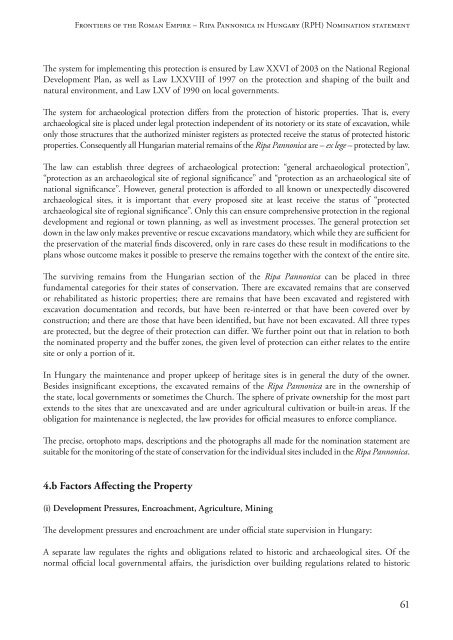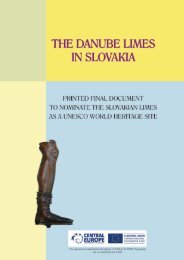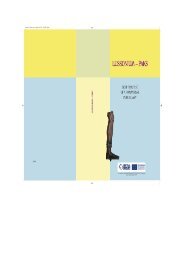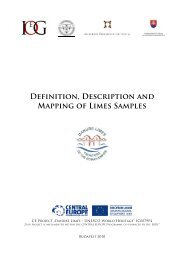the PDF version! - Danube Limes
the PDF version! - Danube Limes
the PDF version! - Danube Limes
You also want an ePaper? Increase the reach of your titles
YUMPU automatically turns print PDFs into web optimized ePapers that Google loves.
Frontiers of <strong>the</strong> Roman Empire – Ripa Pannonica in Hungary (RPH) Nomination statement<br />
The system for implementing this protection is ensured by Law XXVI of 2003 on <strong>the</strong> National Regional<br />
Development Plan, as well as Law LXXVIII of 1997 on <strong>the</strong> protection and shaping of <strong>the</strong> built and<br />
natural environment, and Law LXV of 1990 on local governments.<br />
The system for archaeological protection differs from <strong>the</strong> protection of historic properties. That is, every<br />
archaeological site is placed under legal protection independent of its notoriety or its state of excavation, while<br />
only those structures that <strong>the</strong> authorized minister registers as protected receive <strong>the</strong> status of protected historic<br />
properties. Consequently all Hungarian material remains of <strong>the</strong> Ripa Pannonica are – ex lege – protected by law.<br />
The law can establish three degrees of archaeological protection: “general archaeological protection”,<br />
“protection as an archaeological site of regional significance” and “protection as an archaeological site of<br />
national significance”. However, general protection is afforded to all known or unexpectedly discovered<br />
archaeological sites, it is important that every proposed site at least receive <strong>the</strong> status of “protected<br />
archaeological site of regional significance”. Only this can ensure comprehensive protection in <strong>the</strong> regional<br />
development and regional or town planning, as well as investment processes. The general protection set<br />
down in <strong>the</strong> law only makes preventive or rescue excavations mandatory, which while <strong>the</strong>y are sufficient for<br />
<strong>the</strong> preservation of <strong>the</strong> material finds discovered, only in rare cases do <strong>the</strong>se result in modifications to <strong>the</strong><br />
plans whose outcome makes it possible to preserve <strong>the</strong> remains toge<strong>the</strong>r with <strong>the</strong> context of <strong>the</strong> entire site.<br />
The surviving remains from <strong>the</strong> Hungarian section of <strong>the</strong> Ripa Pannonica can be placed in three<br />
fundamental categories for <strong>the</strong>ir states of conservation. There are excavated remains that are conserved<br />
or rehabilitated as historic properties; <strong>the</strong>re are remains that have been excavated and registered with<br />
excavation documentation and records, but have been re-interred or that have been covered over by<br />
construction; and <strong>the</strong>re are those that have been identified, but have not been excavated. All three types<br />
are protected, but <strong>the</strong> degree of <strong>the</strong>ir protection can differ. We fur<strong>the</strong>r point out that in relation to both<br />
<strong>the</strong> nominated property and <strong>the</strong> buffer zones, <strong>the</strong> given level of protection can ei<strong>the</strong>r relates to <strong>the</strong> entire<br />
site or only a portion of it.<br />
In Hungary <strong>the</strong> maintenance and proper upkeep of heritage sites is in general <strong>the</strong> duty of <strong>the</strong> owner.<br />
Besides insignificant exceptions, <strong>the</strong> excavated remains of <strong>the</strong> Ripa Pannonica are in <strong>the</strong> ownership of<br />
<strong>the</strong> state, local governments or sometimes <strong>the</strong> Church. The sphere of private ownership for <strong>the</strong> most part<br />
extends to <strong>the</strong> sites that are unexcavated and are under agricultural cultivation or built-in areas. If <strong>the</strong><br />
obligation for maintenance is neglected, <strong>the</strong> law provides for official measures to enforce compliance.<br />
The precise, ortophoto maps, descriptions and <strong>the</strong> photographs all made for <strong>the</strong> nomination statement are<br />
suitable for <strong>the</strong> monitoring of <strong>the</strong> state of conservation for <strong>the</strong> individual sites included in <strong>the</strong> Ripa Pannonica.<br />
4.b Factors Affecting <strong>the</strong> Property<br />
(i) Development Pressures, Encroachment, Agriculture, Mining<br />
The development pressures and encroachment are under official state supervision in Hungary:<br />
A separate law regulates <strong>the</strong> rights and obligations related to historic and archaeological sites. Of <strong>the</strong><br />
normal official local governmental affairs, <strong>the</strong> jurisdiction over building regulations related to historic<br />
61











